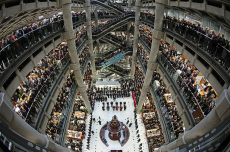
London, as a city with strong links to its river, traditionally made a lot of money through trade. Ships would follow the river from the sea into the heart of the city to deliver fruit, fabrics, tea and many other valued goods to be sold to the public. This was before the rivers width had been restricted, so it was far bigger and large ships could easily travel along it. You can still see remains of this trade around the City, in street names such as Lime Street, a remnant of what used to be sold there.
The City of London, otherwise known as the City, became a major marketplace for insurance during this time. Ships represented a big risk – the people who owned the goods being transported often had to wait months for their investment to be returned. There was a risk of sinking, pirates, spoiled produce, fires, and many others. Basically, they wanted some reassurance that even if they never received the silk or oranges or coffee they were waiting for, their venture would not have been a waste of money. That’s where insurers came in. They promised that if they were paid a ‘premium’, a one off or annual fee, they would pay the insured whatever money they had lost if the delivery was compromised. Most of those deals were made in a coffee shop that nowadays has become Lloyd’s of London (not to be confused with Lloyds TSB) the biggest insurance market in the country.
In a modern day insurance company underwriters go to the Lloyd’s building, where brokers (who represent people or companies who want to be insured) approach them and pitch their business. The underwriter then decides whether they want to insure that risk on behalf of their company and decide on a price to set the premium as by putting information into a model, which is a computer program that takes in data about a risk and produces a price for the risk. For example if it is a model for insuring a building it may ask the size of the building, its age, and if it is in an area prone to natural disasters like hurricanes. These models are built by pricing actuaries. Actuaries have to undergo a series of examinations, much like accountants, before they are fully qualified. Reserving actuaries look at data from past policies to try to predict how much each new policy will cost the company. The industry continues to make money because although some policies are very risky (likely to incur a large claim or many claims), premiums are nearly always larger than claims. Reinsurance exists to help cover extremely risky policies like satellites or the building of a skyscraper. This means one company will insure another company’s risk. This could be by paying a percentage of every claim or by paying anything above a certain value, say £500,000. In this way, if a huge claim comes in then the insured will receive all the money they are entitled to without the company going bust.
Despite its reputation for being dull, insurance is a varied and interesting area of business. Insurance companies usually offer a variety of policies, from kidnapping to satellites. Current events affect day to day work in insurance more than most other areas of finance, in that an earthquake or flood will cost the company a lot of money in claims, but will also make other people realise that they need insurance and bring in more money in premiums. This makes the whole industry self-sustaining.
Image credit: http://i.telegraph.co.uk/multimedia/archive/01759/lloyds_1759329b.jpg (Image shows the interior of the Lloyd's building)

0 Comment:
Be the first one to comment on this article.